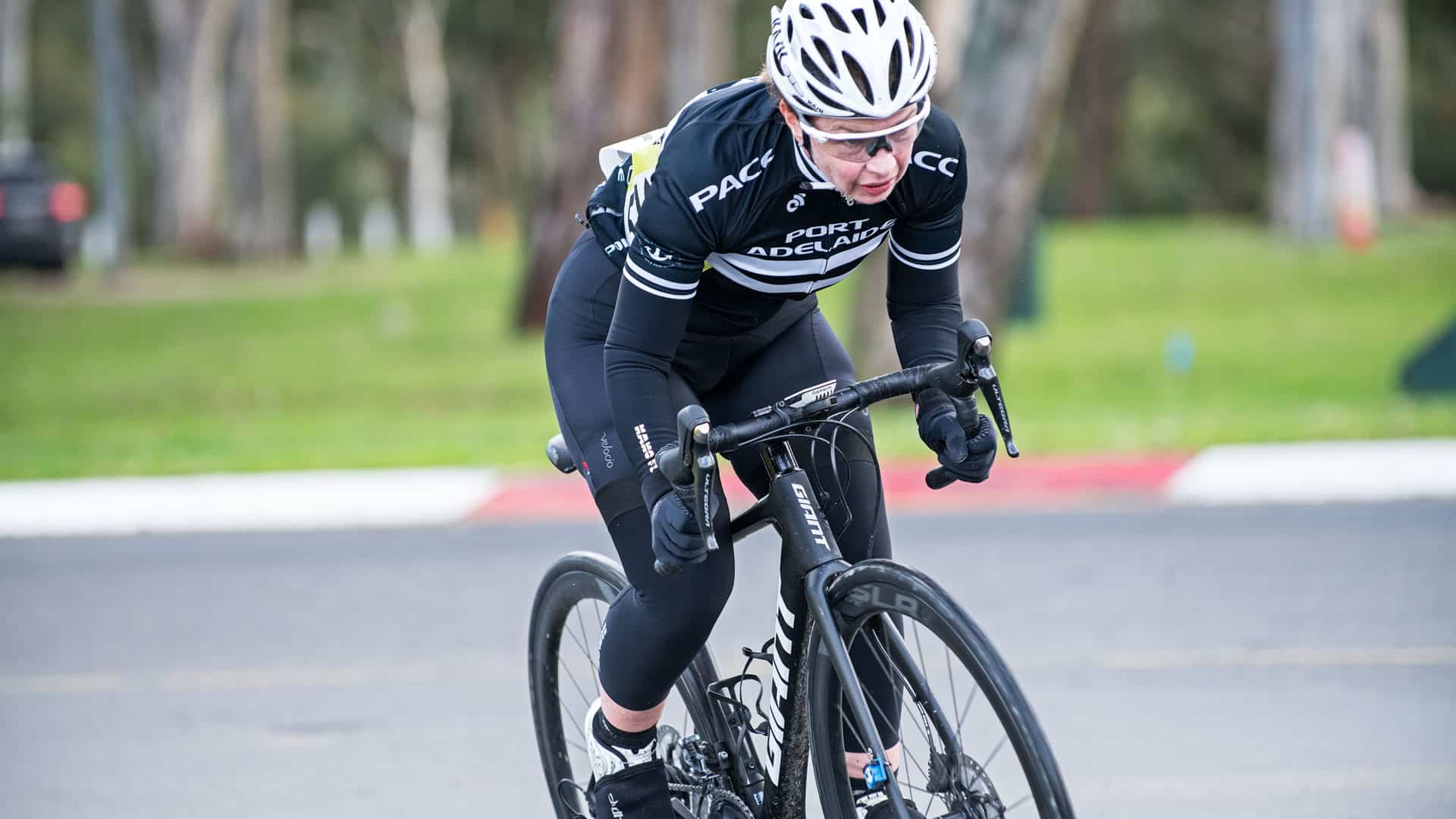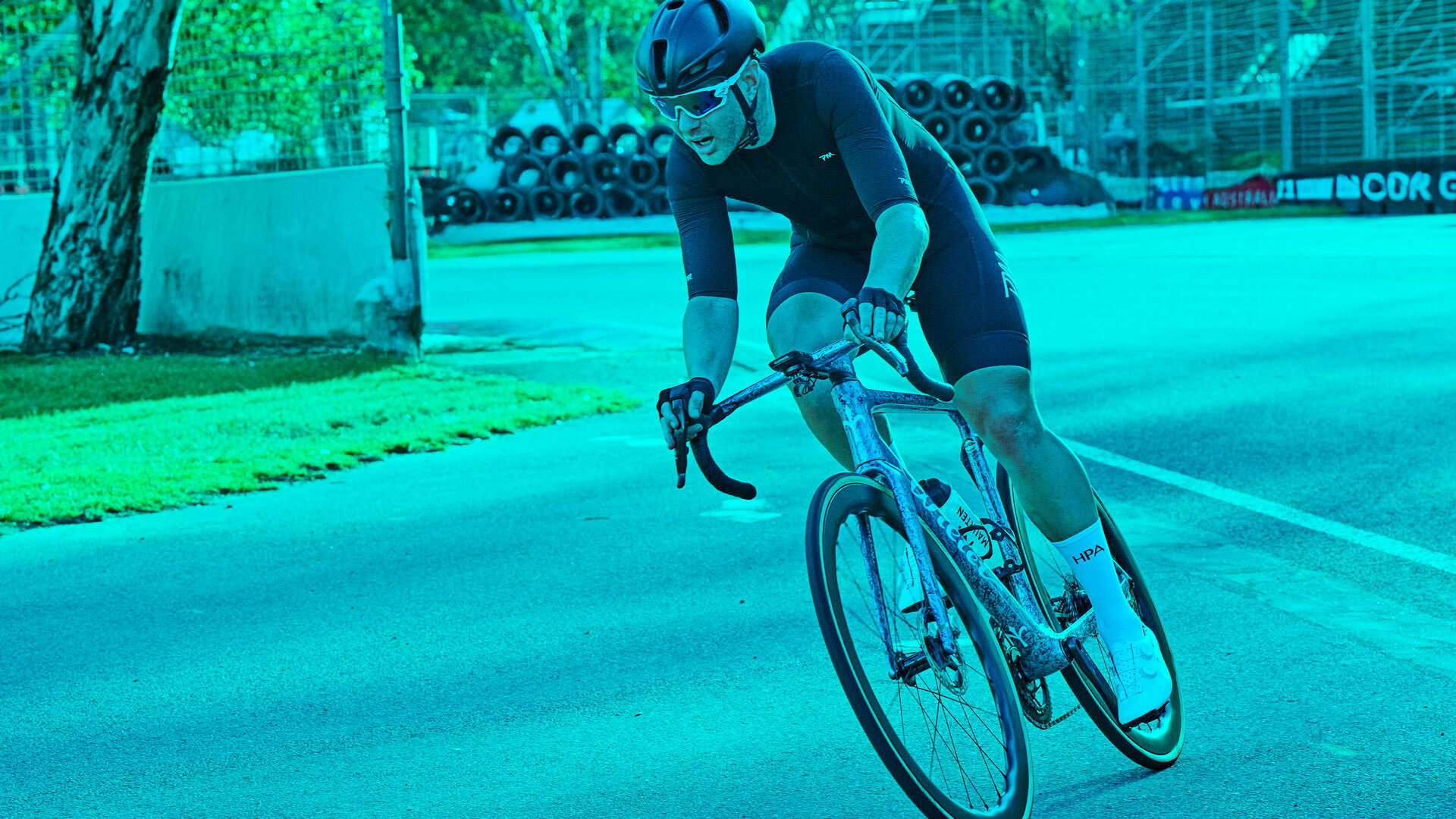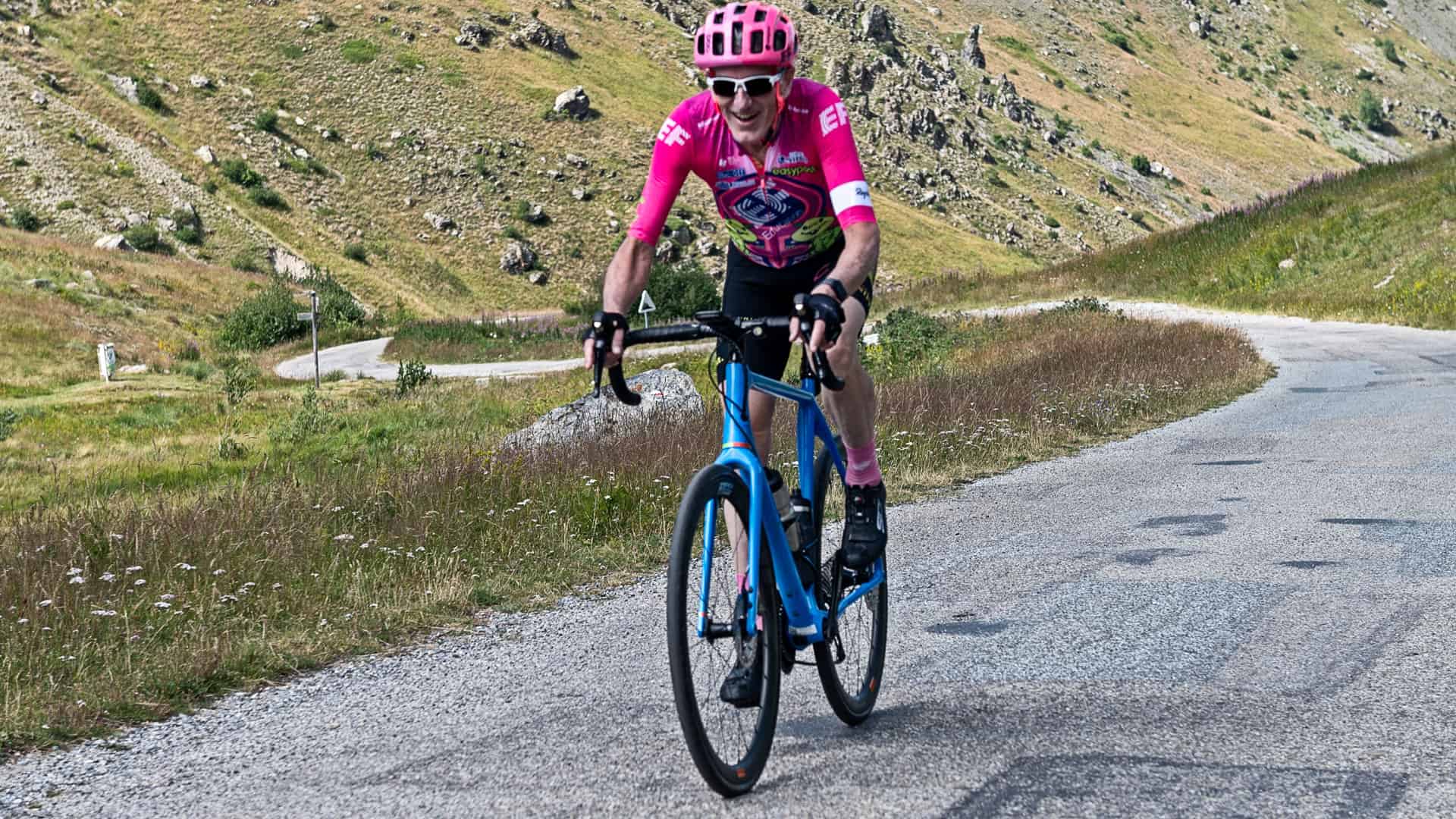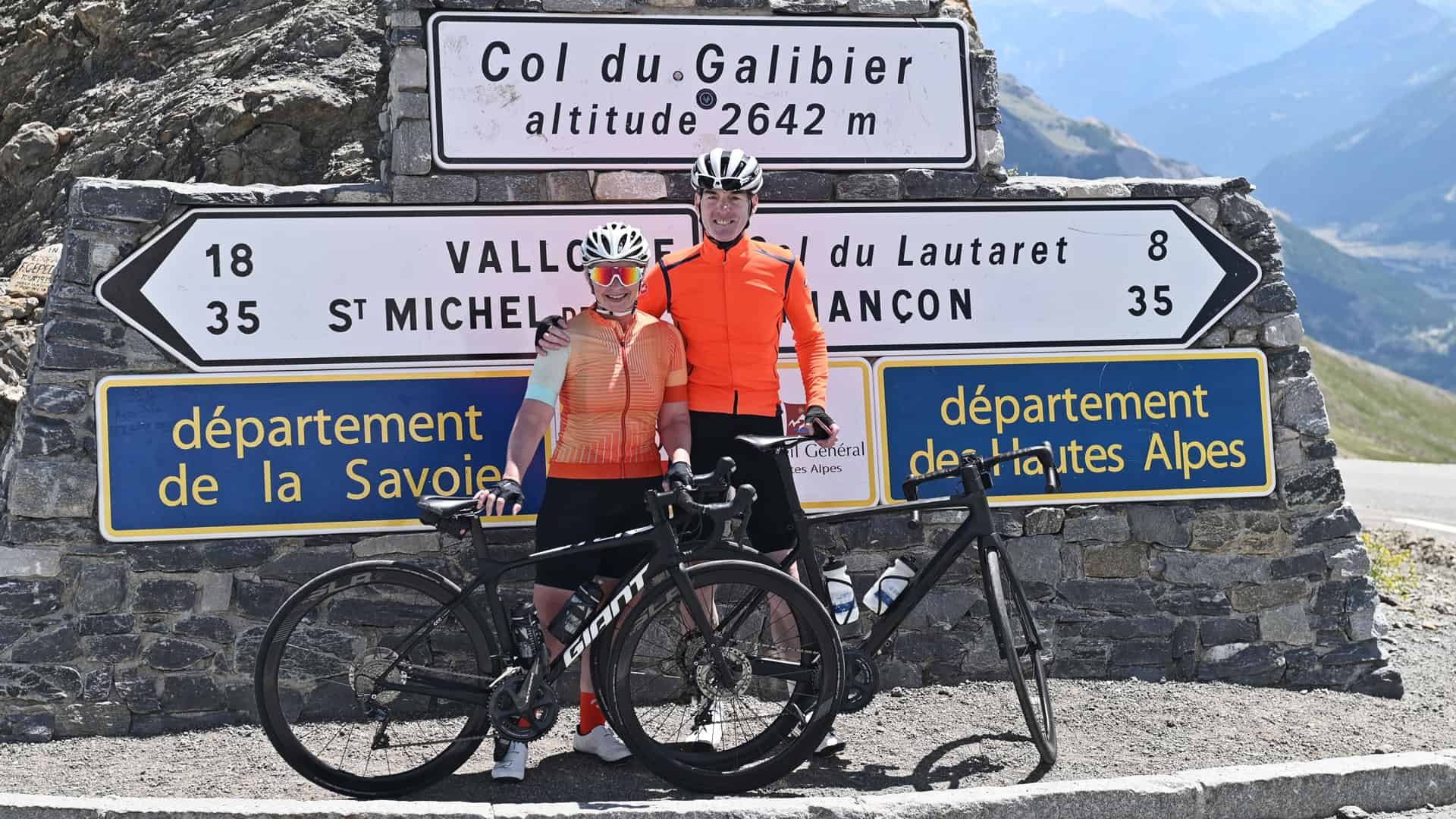Transcript
So let’s talk about your cycling journey. Now everybody’s on their own cycling journey, but generally they start out at some point at the beginning and they jump on a bike. And now you could have jumped on a bike at an earlier age, or you could have jumped on a bike in your later years. And you started riding, Okay, this is a really bad picture of a bike. This is probably the worst one ever. Anyway, so there we go.
You’re on your bike and you get hooked, all right? And at some point, you get some peddles with some cleats. You clip into them and you fall off your bike. That’s happened, everybody does that, all right? And then you start thinking about, “Hey, I’m really enjoying this. It’s helping with my fitness. I’m feeling a lot happier. It’s great for my head. And you start thinking, “I want to challenge myself a bit further.” So you start doing a few longer rides, right? Longer rides. That’s an R and not a C. And then you might have a friend or you see an event being run and you start doing some events. And then suddenly you keep progressing with this to the point where you make a decision on whether you want to become a racing cyclist.
Or you just want to continue being an awesome recreational rider. Yep. Now, of course, you can take this as far as you want, which is fantastic. Racing cyclists, we’ve got people that are competing at national, state and international level with their cycling. And we’ve got recreational riders. You may aspire to go on to do local events here in your local country, and you may want to then travel internationally and do some of the epic rides that they’ve got over in Europe that are usually supporting rides for a lot of the epic races. For example, I went over to France and did with Jody, my wife, and we did Paris Roubaix and it was amazing. Never wanted to race it. Loved riding it and you might want to get on and do some cycling tour.
So there’s lots of options around where you can take your cycling. So somewhere along this journey, you’re going to run into a problem. And that is around your performance. And that you want to go on and do these amazing things with your riding here, but your performance is not matching the outcome that you want. And there could be a lot of reasons for that. We’ll cover that later on.
All right. So let’s talk about how we start solving those problems around performance. And I’ve got this little diagram here. Hope you can see it. And then we’re going to be talking about this, and this. So let’s talk about the first issues. Now, a lot of people think that they get performance from speed, all right? S-P-E-E-D. There’s a lot of information out there, a lot of scientific research and don’t get me wrong, scientific research is fantastic. And it says that if you do speed work or hit sessions and stuff, you get fast.
And we know that. We know that when we throw speed work at cyclists, the performance lifts, but the problem with speed work is that it’s the icing on the cake. There’s a whole lot of stuff that we need to do below the icing that’s really, really important to get a good lift because the problem with speed work is, it’s developed quickly and it’s lost quickly. Developed quickly and lost quickly. And there’s a ceiling to how much speed work you can do before you burn yourself out, all right? And that’s what we’ve found. A lot of the research that you’ll see out there around high intensity interval training, you’ll see that they do samples around the athletes or the people that they pull off the street, depending on the research.
And they run them through an eight week cycle, or a 12 week cycle. But the reality is that your cycling journey’s a lot longer than eight weeks or 12 weeks, right? And what we found that was when athletes were doing a high intensity interval training, we tried to do this, doesn’t work for us because we found that when we ran athletes through a high intensity training programme for eight or 12 weeks, we got a good lift. But after that, they started to plateau or go backwards. That’s a pretty major issue if you’re working on your cycling journey right through here. And this is the 10 year plan, right? So, that was one of the issues with speed work. You’ve got to understand that speed work’s about… Speed work’s kind of like adding nitro to a car.
So I’m going to draw a really bad picture of a car here. It’s going to be the worst picture ever. Yeah, this is turning out to be the worst car on the planet. All right. Okay. It looks like a UFO on wheels. Cool. All right. So the thing about this is that if you’re driving around in a car that’s really designed to drive around the around town, like a little car, like a one point something litre car, that’s just really designed for driving around your local city or that sort of thing. And when you get it out on a highway, it’s pretty ordinary. Now, when you add nitro to that car, it’ll go faster, right? But the problem is that it’s still a little car. There’s only so much nitro you can add to it before it blows up.
And you’re still driving around in a little car. Now, what we’ve found is that there’s a whole lot of other stuff below this that we can do to your cycling performance, to build a bigger engine. So instead of driving around in a little car, you drive around in a much bigger car. So you go from a Toyota Yaris or Toyota Echo, and you start driving around in a Porsche. Now, a Porsche doesn’t need nitro because it’s a high performance car, still the same fuel you’re putting into it, but it goes stack loads faster, right? Now you have to make a decision on whether you want to continue to be a Yaris or a Toyota Echo, or you want to work towards being a Ferrari. And a lot of that comes from… Don’t get me wrong, speed work is an important component of it, but the bulk of the stuff comes from the stuff down here below the icing and the cake.
And this is below this line. Now, this is a representation. This triangle here is, imagine this triangle in the sea and this is speed work, it’s like the iceberg, all right? So just visualise that in your head. All right, so we’ve got this iceberg here. We’ve got speed work at the top. I’ve talked about what that’s about, and we’ve got these other levels. So the first level that’s really important is consistency, all right? I’ll just draw C-O-N-S-I-S-T-E-N-C-Y. All right. So, consistency is incredibly important. Consistency is so important. Here’s the thing. If you’re not riding your bike consistently, then it doesn’t matter whether you’ve got a super expensive bike or an amazing set of wheels or a power metre or a heart rate monitor a Garmin computer. If you’re not actually riding a bike and training, then none of that matters, right?
Consistency is super important. And it’s super important to build your overall cycling performance. You need to be consistent. And we look… When we get people come onto our programme, we get two types of general people. The first type of person they’re super consistent with their training, they don’t have any issues around the consistency with their training. The issues that they have is that their training doesn’t match their outcomes. So although they’re consistent, the training that they’re doing is not matching the outcome that they want. And therefore that don’t get their performance.
They don’t get the performance results they want to meet what their overall goals are. The other athlete that comes onto our programme has big issues with consistency, all right? And we’ve got stack loads of stuff to help you with that. Anyway. So those are the two types of people and the types of issues that they have. So consistency is the most important thing. So the next level is base. All right. Now, a lot of people poopoo base, and a lot of these people up here that think high intensity training is the holy grail to solving all your training problems.
A lot of people in that area think that that’s the case, poopoo base. They think that base is something that there’s this theory about junk kilometres. Now all we’ve been training people for over 12 years now. We’ve never seen this thing. When we get people doing more base work, their overall performance lifts, all right? And here’s the thing about base work is that if you’ve got an event, say your event is 160 kms long, or a hundred miles. All right. Now, if you’re doing high intensity interval training sessions for 60 minutes, all right, smashing yourself silly on a home trainer, thinking that you’re training.
Don’t get me wrong, home training is a fantastic way of improving your performance. And there’s a lot of stuff that we do with home training sessions that are very, very important to your overall development, but understand that cycling is more than just smashing yourself silly on a home trainer for 60 minutes thinking that you’re training, because here’s the issue with that is that 60 minutes into your ride, you’ve trained yourself to ride fast for 60 minutes and you get onto the event and you get to 60 minutes, all right? Which is the depth of your training. And then from there, your performance, basically looks like this. You’re riding fast and then you’re not riding at all. Riding really badly.
So base is the next important thing. And for a lot of people, they’re riding for an event. Well, we don’t worry about speed work to start off with, because what we want to do is make sure that the athlete’s actually capable of having the endurance to get to the end of the ride and not feeling like they need to hang up their bike and take up lawn balls, right? We actually need to build out a decent level of overall endurance, fitness, and base to get them to the event feeling fresh and awesome, all right? And then once we’ve got them getting to the end of the event, feeling fresh and awesome, then we can start working on speed work, but there’s no sense working on speed work first, right? No sense because they’re going to ride the first 60 minutes fast and then they’ve got nothing for the rest of the ride. All right. So the next one on the list is strength.
Okay. Now strength is really important as well. And we actually combine these two together, all right?? Now, both base and strength help build a bigger engine. They change you from being Toyota Yaris or Toyota Echo, one of those and not putting down those cars, they’re great for what they were designed for, into a high performance racing car, right? Or a high performance car. So strength and base are a little bit different to speed work. Speed work is developed quickly and lost quickly, all right? So if you’ve got consistency issues with your performance and you’re doing a lot of speed work, then that’s probably the issue. Now strength work and base training they’re developed slowly and lost slowly. So they actually help with your overall consistency with your performance. And the good thing about strength training is that when you combine it with base training, you get actually a natural speed lift.
It’s like, this is what makes your performance get really good at selecting the icing underneath it. Sorry, it’s a cake underneath the icing, right? Strength work helps with base work, combined together helps you hill climb better. You need to be able to develop power at low cadences. And that’s what strength work is, it helps improve your FTP. It helps you manage bunch surges. And when bunches are riding fast and it basically makes you fast. This is the reality. I’m not trying to BS you here. We have spent the last 12 years working with athletes and it’s like, this is the area that produces the best bang for your buck, all right? And speed works kind of like the icing on the cake. Don’t get me wrong, speed work’s really important. Now the other level of performance that we need to work on as well is technique.
Now, why is technique important? Well, look, here’s the thing. Cycling’s like swimming. My dad, I remember watching him in a pool one day. I said to him, “Have you ever done swimming with a flutter board?” He says, “Well I don’t go anywhere, my kick doesn’t actually propel me forward.” And I said, You’ve got to be kidding me.” And anyway, so he demonstrated it to me. He got into the swimming pool with a flutter board and kicked away. And literally, I saw him literally swim backwards. When he was kicking with his legs, he was, I don’t know what he was doing, but his technique was so bad. And no disrespect to my dad, he’s an awesome guy, but his technique was so bad that he was actually going backwards in the pool with a flutter board, kicking away.
That’s how bad his kicking was. In fact, he would have been better not kicking at all. So technique’s really important. And cycling, just like swimming, technique’s super important. And what technique does is it helps improve your overall efficiency. What we’re able to do with technique is that we’re actually able to develop more power in the cycling stroke. So if you could imagine these are your cycling strokes and you power down through here, and then through here, this is the rest cycle. And then your power. Now, what we do is a lot of people develop power through this part of the stroke, but they don’t develop power through here or here. And we teach you how to, with the combination of the strength training that we do and techniques that we do in our base training, we actually teach you how to develop this through off the bike core strength stuff that we work on.
Anyway. So those are the six levels, 1, 2, 3, 4… Oh, 5 levels. Those are the five levels of cycling performance, all right? And where a lot of cyclists go wrong is that they may have a training programme that keeps them busy. But the problem is that it’s not targeted to meet their goals, all right? So they’ve got a training programme that they’ve got from the internet or downloaded for free somewhere or whatever, and they’re working through it and it’s keeping them busy, all right? But because it’s not focused on where their current fitness is at the moment or their goals, that is not meeting their performance requirements. So we see a lot of cyclists with this issue and it just amazes me. I get clients onto my programme and I look at what they’re doing and I have this head-slap moment. “Oh my God, what were they thinking?” Seriously, this stuff is absolutely not going to help them get the results they want.
Now I’ve got some horror stories about what people are doing with their training out there. And there’s usually two or three common mistakes that people are making when they’re riding that means that the training that they’re doing is not matching the outcome that they want. And that’s critical. The better that you’re able to get this the training that you doing, matching the goals that you’ve got, whether you’re a racing cyclist or a recreational rider, whether you’re riding crit racing or time trials, or road racing, or whether you’re a recreational rider that’s doing flat events or hilly events or stage events or whatever, that training that we give you is going to be different depending on what you want to achieve with your riding. And the closer that we’re able to align the training programme to the outcome, the better results you’re going to get. All right.





Leave A Comment